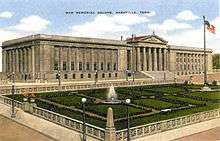Edward Emmett Dougherty
| Edward Emmett Dougherty | |
|---|---|
| Born |
March 18, 1876 Atlanta, Georgia, U.S. |
| Died | November 11, 1943 |
| Alma mater | University of Georgia |
| Occupation | Architect |
| Spouse(s) | Blanche Carson |
Edward Emmett Dougherty, a.k.a. Edwin Dougherty (March 18, 1876 – November 11, 1943) was an architect in the southeastern United States. One of his best known designs was the Tennessee War Memorial Auditorium in Nashville in 1922. The work won state and national design competitions.[1]
Early life
Edward Emmett Dougherty was born on March 18, 1876 in Atlanta, Georgia.[2] He graduated from the University of Georgia in 1895.[2] He then studied architecture at Cornell University and the Ecole des Beaux Arts in Paris.[2][3]
Career
As an architect, Dougherty partnered with Arthur Neal Robinson for a few years. He was also a partner in Dougherty & Gardner and in Dougherty, Wallace and Clemmons.[4]
During the second part of his career from 1916, Dougherty worked in Nashville, Tennessee. In 1917, he designed the Belle Meade Apartments in Belle Meade, Tennessee near Nashville, which is listed on the National Register of Historic Places.[5] He also designed projects for the Nashville, Chattanooga, and St. Louis Railroad.Several buildings designed by Dougherty are listed on the U.S. National Register of Historic Places.[5]
Tennessee War Memorial Auditorium

Dougherty received the contract for a 2,000 seat auditorium, Tennessee's War Memorial Building, now known as the War Memorial Auditorium (1922) in a "spirited competition" according to the Nashville Tennessean.[6] A jury of nationally-known architects devised a competition to narrow the competitors to six; three from Tennessee and three from out-of state. The designers were kept anonymous and the choice was made by a commission of local city fathers at the Hermitage Hotel in Nashville on February 14, 1922. Dougherty's design was the unanimous choice.[6]
Personal life
Dougherty married Blanche Carson on June 5, 1907.
Death
Dougherty died on November 11, 1943, at a Nashville Hospital at age 68.[2] He had suffered a heart attack at his apartment the night before.[2]
Works
- One or more works in Adair Park Historic District, bounded by Metropolitan Pkwy., Lexington Ave., Norfolk Southern RR and Shelton Ave., Atlanta, Georgia (Dougherty, Edward E., et al.), NRHP-listed[5]
- Central Baptist Church, 500 N.E. 1st Ave., Miami, Florida (Dougherty & Gardner), NRHP-listed[5]
- Central Presbyterian Church, 201 Washington St. SW, Atlanta, Georgia (Dougherty & Gardner), NRHP-listed[5]
- Doctor's Building, 706 Church St., Nashville, Tennessee (Dougherty and Gardner), NRHP-listed[5]
- Druid Hills Baptist Church (1925–1928) [1] 1085 Ponce de Leon Ave. NE at Moreland Ave., Druid Hills, City of Atlanta
- Druid Hills Golf Club (1912–1914) [1]
- Guildfor Dudley, Sr. and Anne Dallas House, 5401 Hillsboro Pike Forest Hills, Tennessee (Dougherty & Gardner), NRHP-listed[5]
- Belle Meade Country Club Nashville, 815 Belle Meade Boulevard[1]
- First Baptist Church, 510 Main Ave., Knoxville, Tennessee (Dougherty & Gardner), NRHP-listed[5][7]
- Highland School, 978 North Ave., NE, Atlanta, Georgia (Dougherty, Edward E.), NRHP-listed[5]
- Hil'ardin/Sharp-Hardin-Wright House, 212 S. Lee St., Forsyth, Georgia (Dougherty & Gardner), NRHP-listed[5]
- Home Park School, 1031 State St., NW, Atlanta, Georgia (Dougherty,Edward), NRHP-listed[5]
- Imperial Hotel, 355 Peachtree St., Atlanta, Georgia (Dougherty, Edward E.), NRHP-listed[5]
- One or more works in Valdosta Commercial Historic District (Boundary Increase), roughly bounded by Valley, Lee, and Toombs Sts. and Crane Ave., Valdosta, Georgia (Dougherty, Edward E.), NRHP-listed[5]
- Sam Venable home, also known as Stonehedge Mansion and now converted to St. John's Lutheran Church (Atlanta, Georgia)[8]
- Central Baptist Church, 500 NE 1st Ave. Miami, Florida (with Thomas Gardner)[9] It was built on lots donated by Henry Flagler.
- Gateway to Percy Warner Park, Nashville[7]
References
- 1 2 3 4 Edward Emmett Dougherty; Atlanta's Beaux-Arts architect that got away January 13, 2012
- 1 2 3 4 5 "Dougherty, Dixie Architect, Passes" (Vo.69, No.316). The Greenville News (South Carolina). Associated Press. November 12, 1943. p. 5. Retrieved May 28, 2018 – via Newspapers.com. (Registration required (help)).
- ↑ "Dougherty and Robinson: Native Architects Who Designed Atlanta Landmarks". The Georgian Revival. Revival Construction, Inc. Retrieved January 18, 2014.
- ↑ "The Georgian Revival: Dougherty and Robinson: Native Architects Who Designed Atlanta Landmarks".
- 1 2 3 4 5 6 7 8 9 10 11 12 13 National Park Service (2010-07-09). "National Register Information System". National Register of Historic Places. National Park Service.
- 1 2 "Soldier Memorial Contract Is Given To Local Architect" (Vol.15, No.281). Nashville Tennessean. February 15, 1922. pp. 1, 10. Retrieved May 29, 2018 – via Newspapers.com. (Registration required (help)).
- 1 2 Turner Publishing Company (1996). Robertson Co, TN. Turner Publishing Company. p. 132. ISBN 9781563113055.
- ↑ Stonehenge is mansion and church
- ↑ McBrien, Judith Paine ; iIllustrations by John F. DeSalvo (2012). Pocket guide to Miami architecture (1st ed.). New York: W.W. Norton. p. 66. ISBN 978-0-393-73306-8. Retrieved May 28, 2018.
Further reading
- Ladson, Henrietta O'Brien (1990). Edward Emmett Dougherty and the American Renaissance. Vanderbilt University.